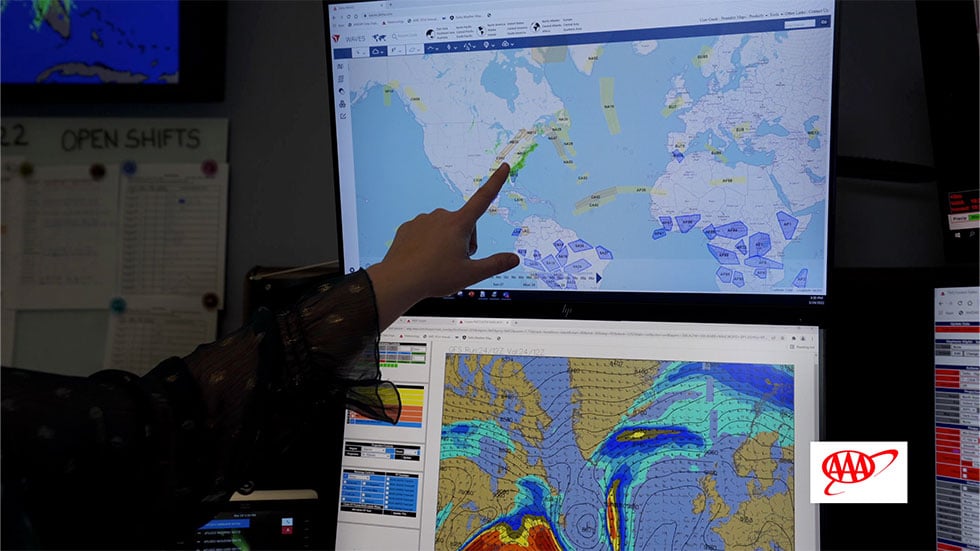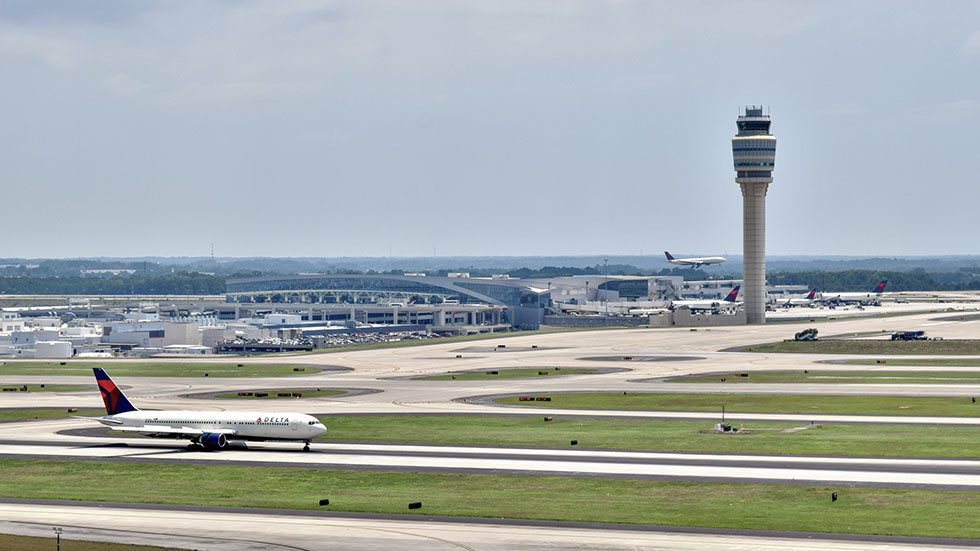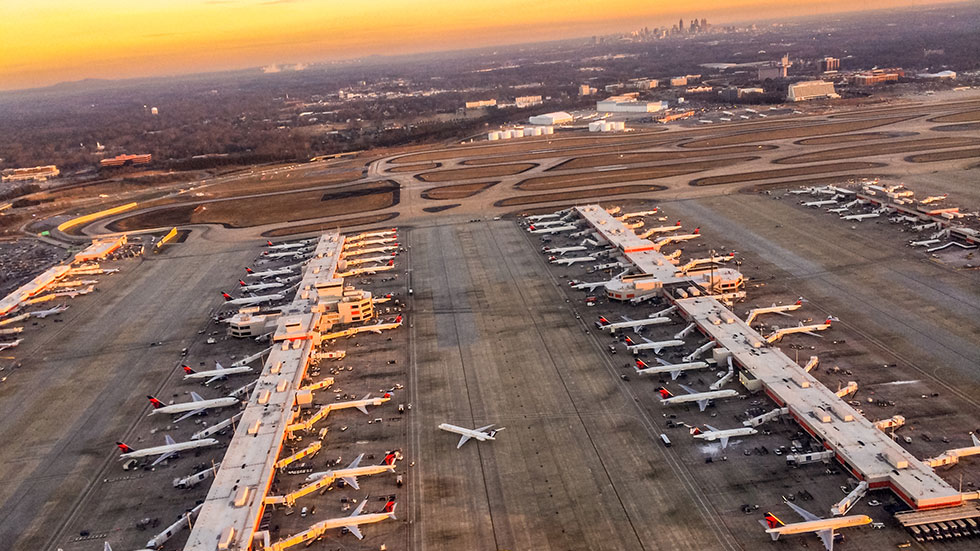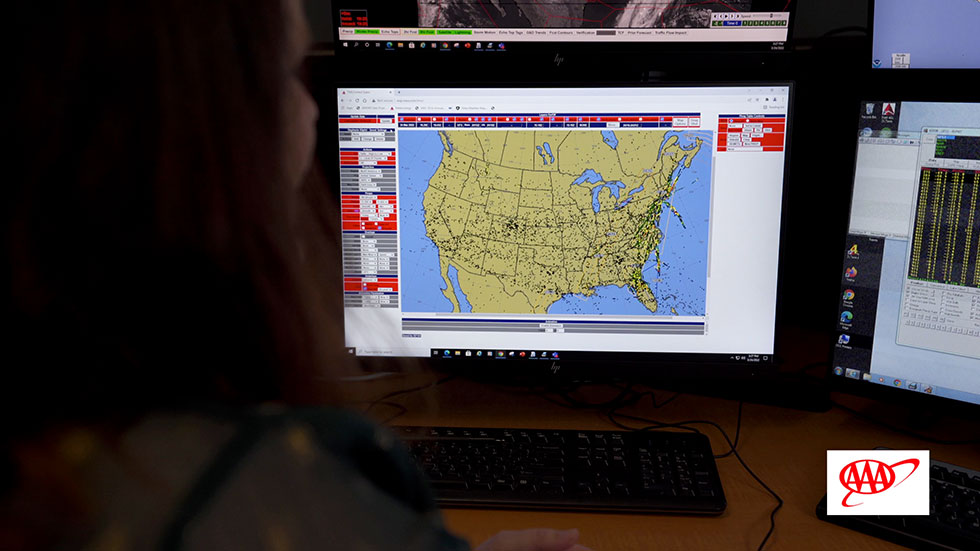
From a quiet corner of Delta Air Line’s Operations Customer Center, Meteorologist Stephanie Klipfel sits in front of six monitors showing radar data, turbulence reports, and other forecast data. Today, she’s watching a system on the east coast bringing low clouds and rain to the airline’s hubs in New York and Boston that should push off the coast overnight.

Klipfel and her team of 28 meteorologists work around the clock from Delta's World Headquarters in Atlanta, Georgia, to track weather conditions on the ground and in the air. Five meteorologists are on the clock 24 hours a day to issue hourly forecasts for all the airports the airline serves. The team works closely with other teams at the Operations Customer Center, including Flight Superintendents (flight dispatchers who plan and track every flight), pilots, and flight attendants.
It takes a lot to join this team of elite aviation meteorologists. Klipfel has more than 20 years of meteorology experience with Delta after getting her start in the field at the University of Kansas. Her team has more than 310 years of combined meteorology experience.

The team has only one concern – getting their passengers and more than 5,000 daily flights to their destinations safely and on time. It's been at the center of everything they do since the original meteorology team was formed in 1938 in Spokane, Washington.
"The impact that we have is making sure that our customers are safe, making sure that the operation is going as efficiently as possible, and identifying those weather risks," says Klipfel. “Every time new data points come in, we’re re-evaluating and communicating that risk to the team.”

Tracking from the ground to above the clouds
To meet the needs of airline operations, the meteorology team is comprised of two types of desks – one that tracks conditions in the upper air and another that tracks conditions at the surface.
The upper air desks focus on in-route hazards, including turbulence and volcanic ash. Each day, meteorologists joining the desk for their shift get up to speed on the weather conditions of the past twelve hours. They start looking at upper air data from various sources so that accurate forecasts can be issued to plan flight paths for a smooth ride with minimal turbulence.
“We try to identify the cause [of the turbulence], and once we know what the cause is, is that area getting worse or better? How long is it going to last?” notes Klipfel. “We put out our products for the next flights that fly through it so they’ll know what to expect.”
According to Klipfel, identifying the cause of turbulence can take anywhere from a few seconds to mere minutes. The team looks for how the winds are moving in lower levels of the atmosphere, generally in the 20,000-to-40,000-foot range, looking for eddies or wind shear that can impact the aircraft experience.

Meanwhile, at the surface desk, the team is tracking and predicting a more traditional forecast at stations, or airports, around the globe with an enhanced focus on Delta's hubs. While providing immediate forecasts is a part of the job, the surface desk also creates long-range forecasts that can time out thunderstorms, snow, and ice that will impact operations on the ground.
“Every station kind of has its own threshold,” says Klipfel. “Meteorology will take all of the weather information and consolidate it down into that hourly forecast. We’ll send it over to our strategic planning team, and they will look at the schedule.”
Based on the surface desk forecasts, the strategic planning team will work with station managers across the country to determine how many flights can arrive or depart under certain weather conditions. They will decide to delay or cancel flights based on how long the weather event is expected to last.
“If it’s going to last for two or three hours, they may be able to delay [the flight] and just operate later into the evening. But if it’s happening at 10 or 11 o’clock at night, they don’t want to delay until two or three in the morning. We try to stay away from that,” says Klipfel. “We’re just trying to minimize any type of disruption.”

Two seasons are more likely to see disruptions due to weather: summer and winter. Pop-up summertime thunderstorms are challenging to predict. They can be isolated in nature, and the timing can be hard to nail down. The difference of a few miles can impact airport operations drastically.
“[Storms] could be directly over the airport, it’s not really moving a lot, and it could last for 40 minutes to an hour. So every flight that was supposed to land for that hour would be disrupted, and that has a trickledown effect. If it pops up just north of downtown [Atlanta], the airport’s fine. We’re going to keep rolling right in and landing all day long,” notes Klipfel. “I think the timing of thunderstorms and knowing precisely where it’s going to occur is probably the toughest for us.”

Meanwhile, winter storms can impact operations at airports for hours or days, depending on the nature of the storm.
“Wintertime is probably a little bit harder for the operation because the snow will slow things down for hours and hours for a large snow event, and that just wears the stations down,” remarks Klipfel. “If it’s a three-day snowstorm and they’re in deicing mode for many, many days, it just slows everything down.”
Ultimately, major weather events can be the most significant disruption to flight schedules. Spring and summer thunderstorms and winter storms in the United States have the potential to be big disruptors. Globally, hurricane and typhoon season in the Atlantic and Pacific Oceans, summer turbulence in the southern hemisphere, and temperatures above 109-degrees can create challenging conditions for airport operations.

Technology makes for a smoother ride
While radar pictures from the National Weather Service and other weather technology tools are essential forecasting tools, new technology enhances the passenger experience as dispatch and pilots work to find a smooth ride once the aircraft is airborne.
One monitor in front of Klipfel, several multi-colored dots cover large swaths of the country. Each dot indicates a report of turbulence from a pilot or an automated feed from the Federal Aviation Administration (FAA) and partner airlines, with the dot's color representing the severity of the turbulence.
“Delta also has automated turbulence reports. The airplane will actually send us reports when it gets into turbulence,” notes Klipfel. “It’s a very objective way for us to get a feel for what’s going on. It’s a minute-by-minute report, so it’s a high level of detail.”
Klipfel and her team can blend the turbulence data with overlays of radar, satellite, or model data to understand what's occurring. They can use the data to help other aircraft find a path around areas of reported turbulence with the help of partners in the Operations/Control Center.

Meanwhile, pilots can view turbulence reports and forecasts on an iPad in the cockpit in the air. The Widget Weather app gives pilots multiple views of the turbulence on the planned flight path with a color-coded display of the airspace using an intensity scale. Since turbulence can't always be avoided, the app helps pilots advise passengers and crew when they need to be seated to avoid in-flight injuries due to rough air.
The app helps makes for a smoother ride, too. In addition to heeding the meteorology team's forecasts and monitoring turbulence with the app, the technology can help guide pilots to smoother air instead of having to search multiple altitudes for a more comfortable ride. The technology ultimately provides passengers with a more comfortable in-flight experience.

Keeping you moving
The meteorology team makes up only a small portion of Delta's Operations/Customer Center. Still, the larger group works closely together with one common goal – making it easy for passengers to get to their destinations without any disruptions or surprises.
“There’s a team of people that’s watching every single flight,” says Klipfel, gesturing to the floor bustling with activity. “We have every customer, every flight, every bag getting to their destination safely. That is our goal. And there’s many times that you are not impacted because of the work of this team.”
That teamwork helps Delta’s passengers travel with confidence, regardless of the forecast.
“The one thing we want our customers to know is that we care about getting our customers to their destination safe and on time.”

